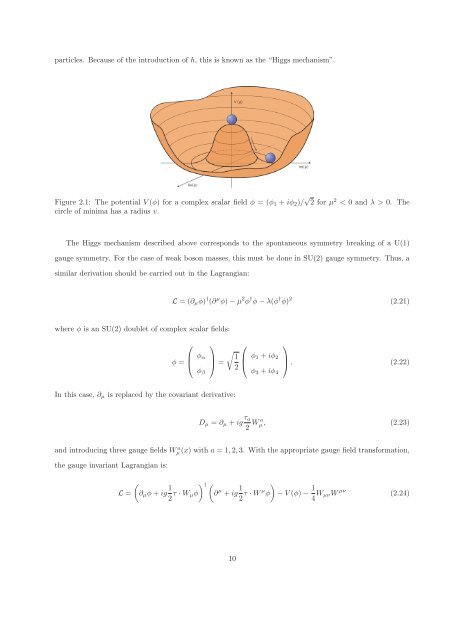CERN-THESIS-2012-153 26/07/2012 - CERN Document Server
CERN-THESIS-2012-153 26/07/2012 - CERN Document Server
CERN-THESIS-2012-153 26/07/2012 - CERN Document Server
Create successful ePaper yourself
Turn your PDF publications into a flip-book with our unique Google optimized e-Paper software.
particles. Because of the introduction of h, this is known as the “Higgs mechanism”.<br />
Figure 2.1: The potential V (φ) for a complex scalar field φ = (φ1 + iφ2)/ √ 2 for µ 2 < 0 and λ > 0. The<br />
circle of minima has a radius v.<br />
The Higgs mechanism described above corresponds to the spontaneous symmetry breaking of a U(1)<br />
gauge symmetry. For the case of weak boson masses, this must be done in SU(2) gauge symmetry. Thus, a<br />
similar derivation should be carried out in the Lagrangian:<br />
where φ is an SU(2) doublet of complex scalar fields:<br />
L = (∂µφ) † (∂ µ φ) − µ 2 φ † φ − λ(φ † φ) 2<br />
φ =<br />
⎛<br />
⎜<br />
⎝ φα<br />
φβ<br />
⎞<br />
⎟<br />
⎠ =<br />
1<br />
2<br />
In this case, ∂µ is replaced by the covariant derivative:<br />
⎛<br />
⎜<br />
⎝ φ1 + iφ2<br />
φ3 + iφ4<br />
⎞<br />
(2.21)<br />
⎟<br />
⎠ . (2.22)<br />
Dµ = ∂µ + ig τa<br />
2 W a µ, (2.23)<br />
and introducing three gauge fields W a µ(x) with a = 1,2,3. With the appropriate gauge field transformation,<br />
the gauge invariant Lagrangian is:<br />
<br />
L = ∂µφ + ig 1<br />
† <br />
τ · Wµφ<br />
2<br />
∂ µ + ig 1<br />
2 τ · W µ φ<br />
10<br />
<br />
− V (φ) − 1 µν<br />
WµνW<br />
4<br />
(2.24)















